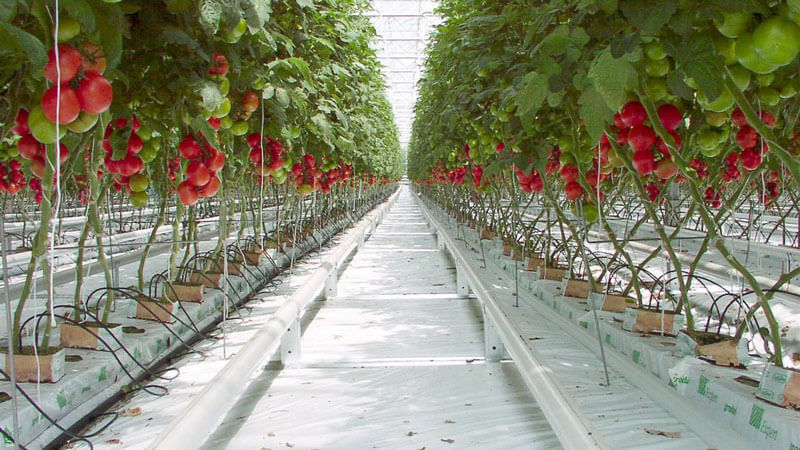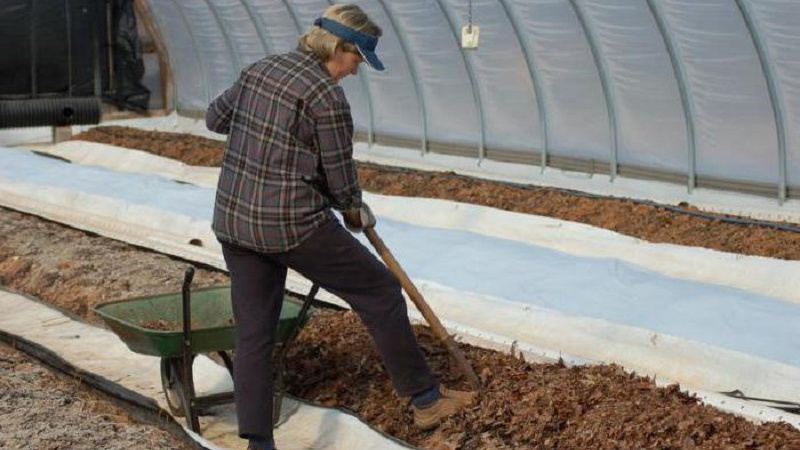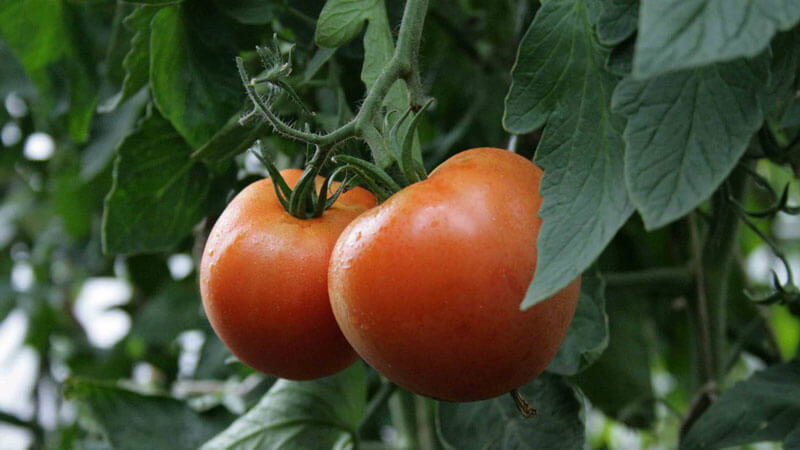How to grow tomatoes in a greenhouse in winter: step-by-step instructions for a rich harvest all year round
Delicious, juicy and healthy tomatoes all year round are the dream of many farmers. Growing these vegetables in large quantities in winter generates profits from subsequent sales.
In this article, we will tell you how to grow tomatoes in a greenhouse in winter and how to sell the harvest.
The content of the article
- Growing tomatoes in a greenhouse
- Methods for growing tomatoes in greenhouses and at home
- Instructions for growing tomatoes in winter
- How to prepare seedlings
- Preparing seedlings and seeds for planting
- Greenhouse soil preparation
- Picking and feeding seedlings
- Caring for tomato bushes
- Grassing tomatoes in greenhouse conditions
- Humidity for normal development
- Secrets of flower pollination
- Greenhouse lighting and heating
- Diseases of tomatoes in winter in a greenhouse
- Top dressing for proper development
- Why growing tomatoes is a profitable business
- Useful Tips
- Conclusion
Growing tomatoes in a greenhouse
To make tomatoes happy with a rich and healthy harvest, you should take care of the premises in advance and choose the desired variety. Summer temporary constructions and traditional garden varieties are not suitable for the cold season.

Preparing the greenhouse for winter use
For growing tomatoes in winter, capital structures are erected and equipped with a powerful heating system. Greenhouses are installed on a sturdy metal frame with anti-corrosion coating. Walls and roofs are made of glass or polycarbonate.
Attention! Polycarbonate will reduce heating costs. It will create a thermos-like atmosphere inside the room. If the summer resident wants to grow a winter crop of tomatoes, several heating devices will be required.
The size of an ordinary greenhouse is 100–500 m2, an industrial one is about 1,000 m2. Tomatoes need a tall, wind-protected structure.
Choosing the right variety
To select the desired variety, they are determined with its characteristics:
- yield - plants with high productivity significantly increase income;
- growing season - the faster the fruits ripen, the more profitable the business;
- disease resistance - a good variety is not subject to fungal and infectious diseases, does not require regular treatment with chemicals;
- taste - the fruits have a sweetish fleshy pulp with a pronounced aroma;
- size and color - buyers choose medium-sized vegetables in rich red, pink or yellow;
- resistance to damage - manufacturers indicate on the packaging information about the duration of storage of tomatoes and their tolerance for transportation.
The most popular varieties:
- early and mid-season - Present, Aksinya, Cherry, Eupator, Kostroma, Palenque;
- hybrids with a short growing season - Verlioka, Rhapsody, Kaspar, Sprinter, Etude, Farmer;
- varieties with a pronounced taste - Honey saved Pink honey, Orange King, Asteroid, Lady, Ballerina.
reference... Growers are placed in the same greenhouse 2-3 different varieties for reliability. Growing tomatoes is not an experiment, but high yields.
Methods for growing tomatoes in greenhouses and at home
Sowing in open ground is not a good idea: seed germination with this method is low. Tomatoes are grown in winter greenhouses using the seedling method. Seeds are purchased, germinated, the sprouts are placed in temporary containers, and then planted in open ground. Moreover, the composition of the soil affects the amount of the crop. The whole process from growing to ripe fruit requires care, diligence and patience.
At home, tomatoes are grown:
- On the windowsill... For this, a special substrate is purchased - a universal mixture, mineral and nitrogen-containing fertilizers for feeding.
- On the balcony... In addition to purchasing soil and fertilizers, they monitor the temperature and lighting in the room.
- Hydroponics... It is important here to provide the root system of the culture with a sufficient amount of minerals, water and oxygen.
Advice! To get a good harvest of tomatoes at home, the first two methods are preferable. Their effectiveness has been proven in practice.
Instructions for growing tomatoes in winter
Getting down to practice - we bring to your attention a step-by-step algorithm for growing a winter crop of tomatoes.

How to prepare seedlings
Grow the crop in the fall to plant it by early November. If it is not possible to prepare the material by this time, it is saved until January.
For this:
- periodically watered with warm water;
- maintain the room temperature + 20 ... + 22 ° C.
Important! Finished seedlings have 6-8 true leaves, buds and a massive, low stem.
Preparing seedlings and seeds for planting
The seeds are prepared as follows:
- Before soaking, they are hardened: wrapped in a wet cloth and left for 2-3 hours, then placed in the refrigerator for 7-8 hours. So 10 days alternate.
- After hardening, weak and healthy seeds are revealed. Defective grains do not have sprouts, while healthy grains hatch in 5-7 days (they are prepared for soaking). To cull the seeds, they are dipped in a saline solution (1 teaspoon of salt in a glass of water) and kept for 10 minutes. The specimens that have surfaced to the surface are unsuitable for planting.
- Soak the material in growth promoters 20-30 minutes.
- Finished seeds are placed in containers with fertile soil and watered well.
The seedlings are planted in a permanent place together with a part of the soil, not burying them in the holes, but leaving them 1.5–2 cm above the ground. This way the plants will avoid the risk of infection.
Attention! Before planting in the greenhouse, tomatoes are hardened for 2-3 weeks, gradually reducing the temperature in the room and regularly airing it. If the buds have already formed, then 4-5 days before picking to a permanent place, the bushes are sprayed with a solution of boric acid (1 teaspoon per 10 liters of water).
Greenhouse soil preparation
The land is prepared from equal parts of sod soil and humus. A layer of the mixture (10–12 cm) is poured onto preheated biofuel. The prepared soil is gradually poured onto the roots and the layer is brought up to 20 cm. If there is no biofuel, then a 16-18 cm layer of the substrate is poured. For the entire growing season, this layer is brought to 25 cm.
Biofuels can be replaced with straw bales. So the bushes will not suffer from streak, brown spot, root rot. In this case, the harvest is removed 7-10 days earlier.

Grower tips for using straw bales:
- any straw will do, except for herbicide-treated straw. For each 1 m2 of plot, 10-12 kg of material is prepared;
- the soil is treated with a weak solution of potassium permanganate or "Nitrafen";
- the bales are poured with boiling water, sprinkled with dry fertilizers, watered again, but with cold water. This allows the fertilizer to penetrate better into the straw. Then scalded again with boiling water;
- after 7-8 days, add a 10 cm layer of soil and additional components: per 100 g of material, add a mixture of 1 kg of lime, 1.3 kg of urea, 1 kg of potassium nitrate, 1 kg of superphosphate, 0.5 kg of potassium sulfate.
For the entire period of tomato growth, the soil is mulched with straw 2 times. Seedlings are deepened into bales.
Picking and feeding seedlings
When 2-3 true leaves appear, the seedlings are placed in peat-humus pots. The main thing is not to be late. If the abundant formation of future roots is allowed, then when transplanted into a greenhouse, the embryos will break and the plants will weaken.
When diving, pinch off the main spine by 1/3. This will stimulate the branching of the root system.
Moderate watering (2-3 times a week) and top dressing are important:
- a week after the pick;
- after the formation of 4 leaves;
- after the formation of 6 leaves.
For fertilization, 1.5 g of ammonium sulfate is diluted in 1 liter of water. Pour 20 ml per 1 bush.
Caring for tomato bushes
After transplanting the culture to a permanent place, water it only after 10-12 days. Then - every 8-10 days. If the ground dries out quickly, the temperature in the greenhouse is lowered.
Additionally, a trellis is installed. Along the landings at a height of about 2 m, a strong wire is pulled, attached to the supports. Then the twine is pulled: one end of the rope is tied under the second leaf, and the other is fixed on the wire.
Attention! Watch the stems as they begin to twine. If the rope is too tight, plants will be damaged and die.
Grassing tomatoes in greenhouse conditions
To get an early harvest and increase the duration of fruiting, secondary shoots are removed in the axils of the leaf plates. Leave one lower stepson and form a bush of two stems. Shoot length - 3-5 cm. Also remove the lower leaves near the ground.
Humidity for normal development
The ideal air humidity for tomatoes is 60–70%. A hygrometer is installed in the room and the indicators are monitored.
Secrets of flower pollination

There are two methods of pollination of plants in winter, when insects have long been dormant:
- plant parthenocarpic hybrids capable of self-pollination. However, this does not always end with success and farmers are not advised to apply the method to beginners;
- use a simple brush with natural bristles and gently touch it to the flower for 2 days after full disclosure. The temperature in the greenhouse should be + 23… + 25 ° C, and the humidity should be 70%. These are optimal conditions for the transfer of pollen.
Important! Pollination of tomatoes with human hands is a long and painstaking work. Better to arm yourself with support and be careful: the flowers are fragile and break easily.
Greenhouse lighting and heating
Fluorescent lamps are installed in the room: they will shine in blue, which is necessary for the correct development of the bushes. The devices consume little energy and practically do not heat up, which eliminates the formation of burns on the leaves and stems.
For heating, one of the equipment is installed:
- stove - economical, but fire and traumatic;
- gas - economical and easy to use, but requires a ventilation system;
- electric - the most affordable and easy to use. Gardeners recommend choosing an infrared heater.
Which type of heating to choose depends on preference and budget.
Diseases of tomatoes in winter in a greenhouse
Early sprouts can develop Fusarium disease when they wilt, turn yellow, and die. For prophylaxis, the planting material is kept in a solution of "Trichodermina", "Previkura" or weak potassium permanganate.
Attention! If dry rot (fusarium) eats the root system, diseased plants are destroyed. Otherwise, the entire harvest will be at risk.
Top dressing for proper development
The bushes are fertilized 3 times during the entire growing season:
- During the growth of stems and leaves, 0.5 liters of mullein and 1 tbsp. a spoon of nitrophoska is diluted in 10 liters of water. Make 2 liters for each plant. Replace the solution with tincture with bird droppings: add 250 g of fertilizer to a bucket of water and leave for 24 hours. Pour 3 liters under each well.
- When setting the fruits, mix 2 g of potassium magnesium, 2 g of superphosphate, 2 g of ammonium nitrate and 10 liters of water. Use 3 liters per 1 m2 of the plot (the solution is applied with a watering can so that the fertilizer better penetrates the soil).
- To increase immunity, a mixture of 4 g of manganese sulfate, 2 g of copper sulfate, 2 g of boric acid, 2 g of zinc sulfate and 10 liters of water is prepared. Pour 2 liters under each bush.
Important! If you use dry mixtures, then the assimilation of useful components will be slower. Therefore, it is better to make top dressing in the form of solutions.
Why growing tomatoes is a profitable business
Growing a winter crop is very profitable: on average, one bush gives 600-700 g of fruit.At the same time, prices on the market for tomatoes in the spring-winter time are much higher than in the summer peak of their ripening.
How to sell the finished product, the farmer decides for himself. Tomatoes are sold to wholesalers, traded on their own, or prepared canned foods.
Useful Tips

Experienced vegetable growers share tips on caring for tomatoes on various forums.
These recommendations will help you grow a rich winter harvest of vegetables:
- Remove spoiled dry leaves from plants and the area regularly.
- Remove unnecessary inflorescences: on the first brush leave 5 pieces, on the next - 6. This will allow the fruits to appear evenly and have optimal sizes.
- Pollinate tomatoes 3 times a week for more harvest.
- Remove the fruits of a dull color: they will ripen safely in a few days and will not waste the extra forces of the bushes.
- Pluck tomatoes carefully.
Conclusion
Growing tomatoes in a greenhouse in winter is a profitable and promising business. The main thing is to follow the recommendations for caring for the crop, take into account the advice of experienced farmers, check the planting material, timely apply fertilizing and watering, and maintain comfortable indoor conditions. Good care of tomatoes will give a rich harvest.